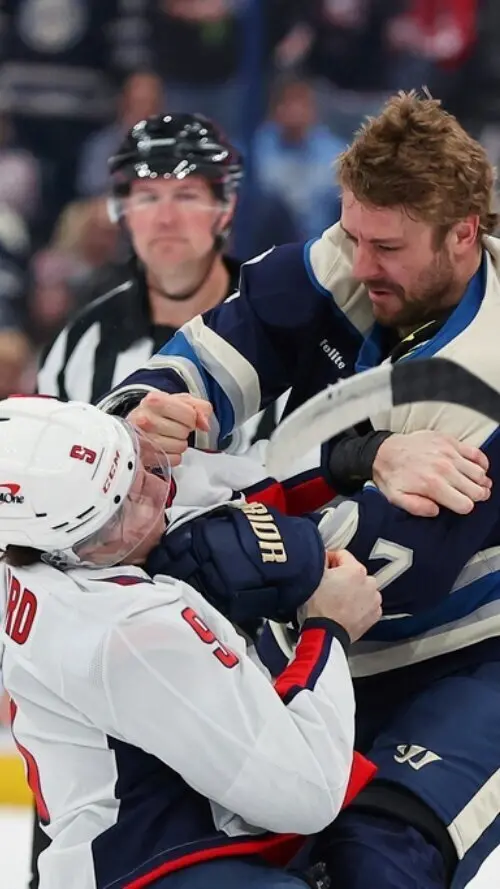
NHL Teams and Players with Most Fights This Season: Who Wins Most Often?
Fighting in the NHL has decreased over the last two decades, but there are still many players who aren’t scared to drop the gloves and scrap. Detractors argue it should be banned due to the risk of concussions, but fighting remains a fixture in the game of ice hockey.
Which teams and players are fighting the most these days? Below, we have compiled the latest NHL fights data for each team in the league, including the best fighters in the 2024-25 regular season based on wins and losses!
NHL Teams With Most Fights This Season (2024-25)
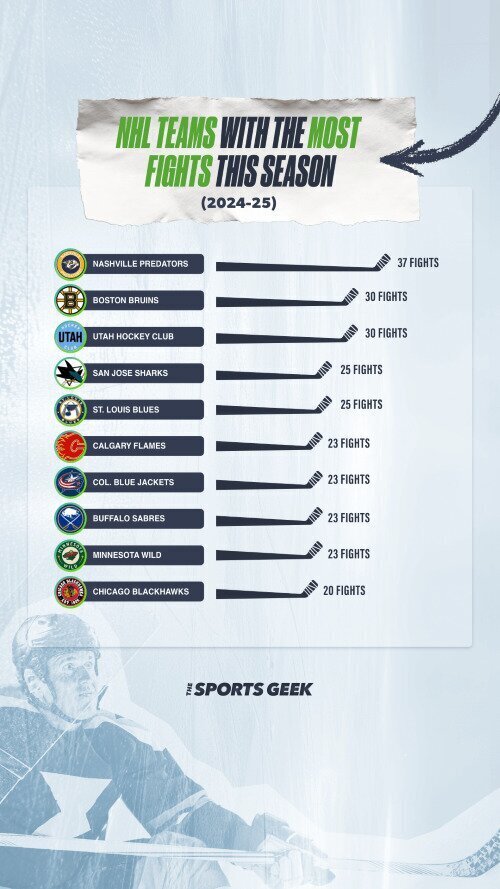
In 2024-25, the Nashville Predators fought the most in the NHL, and it wasn’t particularly close. Predators’ players dropped the gloves 37 times this season, which is seven more than the next closest teams!
Last season, the Predators weren’t shy to fight, either. They recorded the second-most fights with 33 in 2023-24, per Hockey Fights. The Predators turned things up a notch and easily surpassed their total from last season. With fighters like Michael McCarron and Cole Smith roaming the ice, it isn’t much of a surprise.
Michael McCarron sends a vicious right hook right into Logan Stanley's dome. Then flexes for the crowd.
What a scene. pic.twitter.com/LCsawZb5gI
— Alex Daugherty (@AlexDaugherty1) April 10, 2024
The Boston Bruins and Utah Hockey Club tied for the second-most flights this season. Both clubs got into 30 scraps, but it wasn’t enough to compete with the Predators!
Interestingly, only two out of the nine teams in the top 5 are playing in the Stanley Cup Playoffs. The Predators, Bruins, Utah, and Blue Jackets were all eliminated, so any team that had 28 fights or more isn’t in the postseason!
In other words, it might be a good NHL betting strategy to avoid teams that fight too often!
Most Aggressive Fighters in the NHL: What Players Fight the Most?
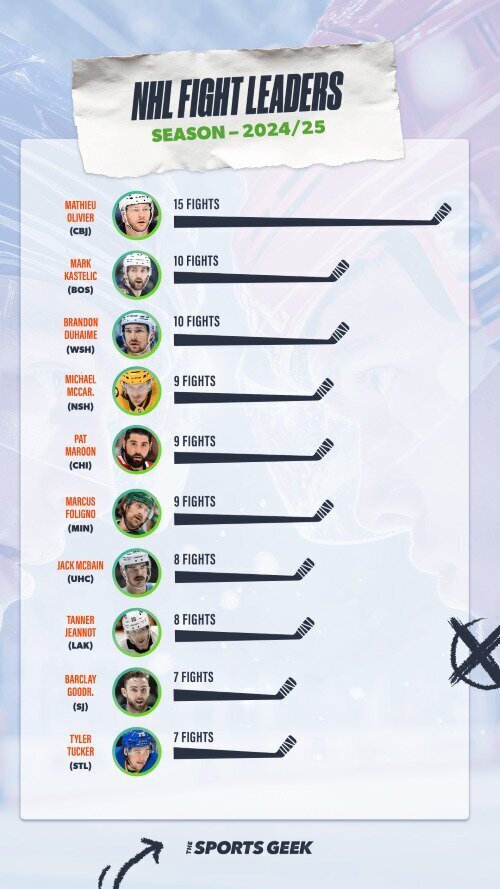
Columbus Blue Jackets’ right winger Mathieu Olivier led the NHL in fighting by far in 2024-25. He had 15 bouts to put him well ahead of his peers. Olivier has no fear and isn’t shy to dance with any player in the NHL.
Following Olivier, the Boston Bruins’ Mark Kastelic and Washington Capitals’ Brandon Duhaime are second in fights with 10. This trio are the only players in 2024-25 to get into the double digits.
Pat Maroon clocks 96 fights in his NHL career 🥊 pic.twitter.com/ChTYne53CL
— B/R Open Ice (@BR_OpenIce) March 22, 2025
An honorable mention has to go to 37-year-old veteran Patrick Maroon who was still throwing fists in his 17th season in the NHL. Maroon tallied nine fights and the 96th of his career this season. The three-time Stanley Cup champion, who is retiring, tied with McCarron for the third-most fights in 2024-25.
Best Fighters in the NHL Right Now by Win Percentage
Now, let’s assess which teams and players were the best fighters according to win percentage in 2024-25. Note that a minimum of five fights was required to make it in our report!
Best NHL Fighting Teams
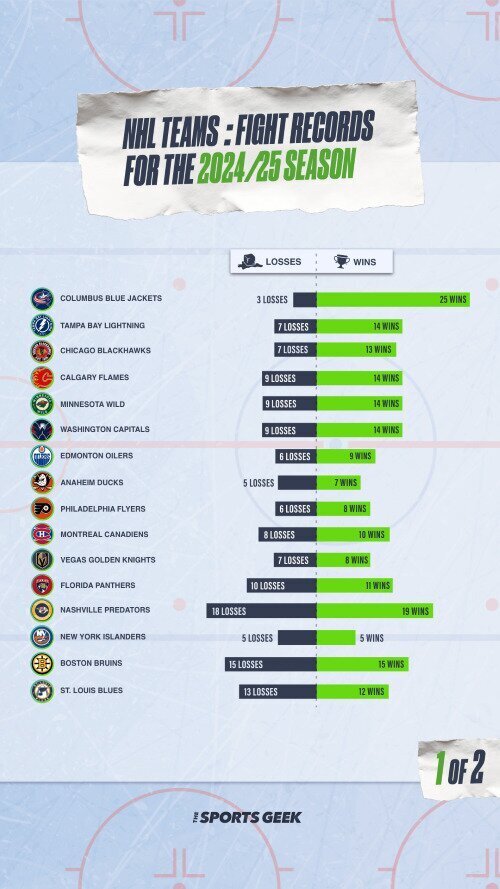
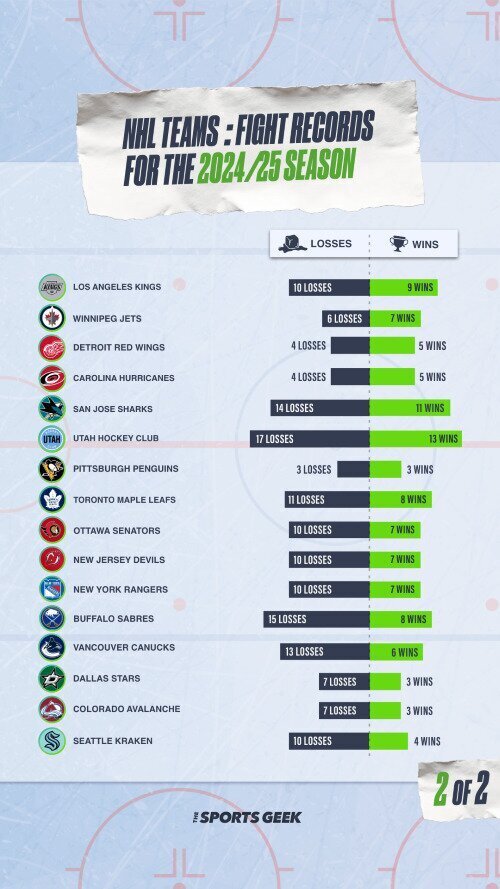
The Columbus Blue Jackets easily had the most success fighting in 2024-25. They weren’t a team to drop the gloves against because the Blue Jackets were overwhelmingly the favorite to win.
With a total of 28 fights, the Blue Jackets won 89.2% of them. The next closest team wasn’t remotely close to the Blue Jackets. The Tampa Bay Lightning logged the second-best fight record at 14-7 and 66.6%.
Six NHL teams finished the 2024-25 season with a win rate of 60% or greater. Meanwhile, 15 squads won at least 50% of their bouts. Despite fighting the most, the Nashville Predators didn’t have too much success.
The Predators had 37 fights but won only 19 for 51.3% wins. Additionally, while the Boston Bruins and Utah Hockey Club weren’t scared to fight, they won just 50% and 43% of their fights this season.
Best NHL Fighters
| PLAYER | RECORD | PERCENTAGE |
|---|---|---|
| Mathieu Olivier (CBJ) | 15-0 | 100% |
| Nathan Walker (STL) | 5-0 | 100% |
| Marcus Foligno (MIN) | 8-1 | 88.8% |
| Brandon Duhaime (WSH) | 8-2 | 80% |
| Brady Tkachuk (OTT) | 4-1 | 80% |
The undisputed king of the ice in fights is Olivier. Without question, he has been the best fighter in the NHL this season. The 28-year-old forward won all 15 of his fights to lead the Blue Jackets to the top fight record in the NHL.
That includes fights against some tough customers, including the Maple Leafs’ Ryan Reaves. Olivier and Reaves traded blows in a close bout, with the American fighter edging out the Leaf due to more punches landing.
Aside from Olivier, the only other fighter to win 100% of their fights (with a minimum of five) is the St. Louis Blues’ Nathan Walker. While Walker doesn’t fight often, he can trade shots with the best of them in the NHL. Marcus Foligno, who is a skilled left winger, was a difficult opponent, too, with 88.8% of wins in nine fights.
Ottawa Senators’ Brady Tkachuk in the top 5 is another example of a player who can make a huge impact as something more than a fighter. The four-time All-Star and member of Team USA fought only five times but won four.
Also, a special shoutout to Maroon, who dropped the gloves nine times and won 78% of his fights at 37 years old!
NHL Fighting Rules
Fighting in the NHL is not banned, but it is against the rules of the game. According to Rule 46 of the NHL, referees are granted very wide discretion in applying penalties for fighting. They shall allow the players to fight until it is safe to intervene, or to prevent serious harm.
The most common penalty issued for fighting is a five-minute major. Although this sounds significant, neither side is short-handed while the five-minute major penalties are served. However, this can change based on whether the officials deem there is an instigator or aggressor.
1. Instigators and Aggressors
Instigators are severely punished with a total of 17 minutes of penalty time: 10-minute misconduct, two-minute minor, and five-minute major. An instigator is defined as a player who starts the fight against an unwilling participant.
Referees can differentiate an instigator by their verbal language, throwing the first punch, or any act that can be described as provoking a player, including a menacing attitude or posture. Typically, fights are mutual, so the instigator penalty isn’t common.
If officials determine the instigator is an aggressor, then an additional game misconduct penalty can be issued. Per Rule 46.2, an aggressor can be described as someone who continues to punch a defenseless player or one who won the fight and continues to throw punches with the intent of serious bodily harm.
Also, players are susceptible to receiving suspensions and fines if the NHL deems the fight was excessively violent. Any player who is an instigator three times in one season is granted a two-game regular season suspension.
Additionally, instigating in the final five minutes of regulation or overtime is susceptible to punishment with a one-game suspension.
2. Penalties to Bystanders
Referees can also punish players who are not directly involved in the fight. When a fight commences, players must go to their bench area on the ice.
If the fight is near one of the team’s benches, they must skate to their defensive zone until the conclusion. Any player who attempts to join the fight (third man in), is levied a game misconduct.
Goaltenders must remain in their crease throughout the fight as well. If the fight takes place near or in the crease, they can leave at the direction of the referee. Any player who doesn’t follow these rules can receive penalty time.
3. Fighting After the Original Confrontation
If players fight a second time after the first altercation, fighters can receive a game misconduct. This prevents players from continuing to drop the gloves throughout the matchup and enhancing tension between teams.
Note that this does not apply to players who were the victim of an instigator. If referees determine that there is a clear instigator, then only that player will be issued the game misconduct penalty.
4. Helmets Must Remain On
When fighting was most prevalent in the NHL in the 1980s and 1990s, players would sometimes take their helmet off before a fight started as a show of toughness and intimidation.
However, today, any player who removes their helmet off willingly is going to be assessed a two-minute minor penalty. The two-minute penalty would grant the opposing team a power player, and as such, rarely happens.
NHL Fighting Stats for the 2023-24 Season
Check out the stats for the 2023-24 NHL season. It was Minnesota Wild who headed the pack last season, although Nashville Predators were again up in the mix. Andreas Englund was the leagues top brawler while playing for Los Angeles Kings.

